Browse using the new Vinous website now. Launch →
Printed by, and for the sole use of . All rights reserved © 2015 Vinous Media
Rieslingfeier – The 2017 Seminars
BY DAVID SCHILDKNECHT I JULY 18, 2017
Rieslingfeier is quite literally “a celebration of Riesling.” But the seminars held as part of this year’s event offered tasting and discussion that were thought-provoking – sometimes to the point of head-scratching – and seriously concerned with the future of Riesling on German and Austrian slopes as well as in the North American marketplace.
The fifth annual Rieslingfeier this past February incorporated an unprecedented four back-to-back seminars involving most of the growers who participated in the subsequent gala tasting and Paulée-style dinner. Attendees, who were very much encouraged to become vocal participants, spanned a wide range of wine professionals as well as Riesling-loving consumer-collectors.
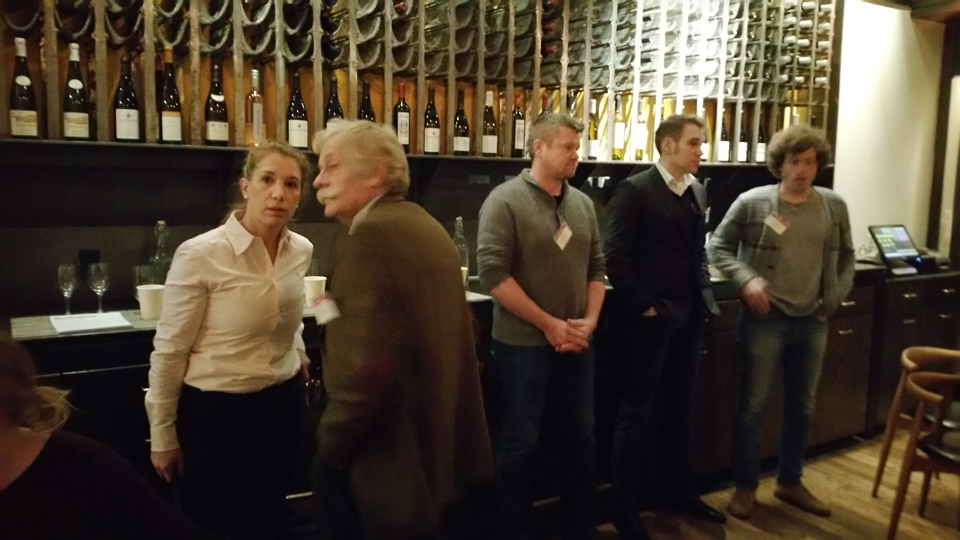
Eva and Hans-Josef Becker, Jochen Beurer, Andreas Hütwohl of Von Winning and Johannes Weber of Hofgut Falkenstein were the ‘Radikals’ featured in a seminar with that title
“Speaking German”
Flight One
2015 Dönnhoff Riesling Hermannshöhle GG
2015 Leitz Riesling Berg Schlossberg “”Ehrenfels” GG
2015 Schlossgut Diel Riesling Goldloch GG
Flight Two
2015 Dönnhoff Riesling Leistenberg Kabinett
2015 Leitz Riesling Klosterlay Kabinett
2015 Schlossgut Diel Riesling Goldloch Kabinett
The day of seminars led off with a panel moderated by sommeliers Raj Vaidya of Restaurant Daniel and Eduardo Porto Carreiro of Untitled at The Whitney and featuring Caroline Diel, Cornelius Dönnhoff and Johannes Leitz. Billed as “trade only,” its aim was to stimulate discussion of how best to promote German Riesling in a restaurant (and to a lesser extent retail) context. Vaidya drew widespread agreement when he pronounced on a disconnect between sommeliers and critics enthusiastic about this genre and a clientele that still needs coaxing. Unsurprising consensus also greeted Porto Carreiro’s observation that “there is room for off-dry as well as dry German Riesling, and the more the better” and his claim that widespread recognition and acceptance of the terms “fruity” and “off-dry” as alternatives to “sweet” had rendered it easier to talk about and convince consumers of German Riesling’s diverse virtues. At the same time, few participants in this seminar or Riesling-loving professionals in general would deny that this genre’s very diversity is also a source of confusion and hesitancy among consumers confronted with a German Riesling and wondering whether it will taste dry or slightly sweet.
The moderators encouraged participants to put the issue of residual sugar behind them so as to discuss other challenges and opportunities afforded in culinary contexts by German Riesling, but it was obvious that the matter of sweetness would not easily die. Someone suggested that a diverse range of analytically dry German Rieslings was disadvantaged on a wine list by its discontinuity with the off-dry or even outright sweet wines that are so often the sole representative of that grape among a restaurant’s by-the-glass offerings. I pointed out that one plausible explanation for this disconnect is that restaurateurs and their sommeliers understandably like the idea of offering at least one wine by the glass that’s both accessible to diners desiring sweetness and also capable of insinuating itself into culinary situations that aren’t well adapted to complete dryness. And if they’re going to offer only one such wine, it’s hardly surprising, given this genre’s amazing and nearly singular talent for integrating residual sugar not to mention its quality/price rapport, that the choice should fall on German Riesling.
In fact, the portfolios of quite a few German wine growers illustrate a similar disconnect: all or most of the wines will be legally dry, but not the entry-level offering. The notion, condescending and misguided though it appears, seems to be that customers need to be gradually weaned off of residual sugar and that those purchasing in the lower price segment are less likely to appreciate a thoroughly dry Riesling. Tara Thomas of Wine & Spirits observed that in collecting testimony for her magazine’s annual restaurant poll, she encountered a number of sommeliers who reported greater success selling Austrian Rieslings than dry Germans. This, I ventured, could be another example of consumer hesitancy in the face of uncertainty. For all of the virtues of Austrian Riesling, its less expensive exemplars seldom deliver the quality/price rapport of a top German Gutsriesling. But they have managed to establish themselves as unambiguously dry. Speaking nostalgically of the respect and market momentum that Alsace Riesling enjoyed when I was beginning my career in the late 1970s and early 1980s, I suggested that this arose in large part thanks to Alsace back then defining itself, in contrast with Germany, as a source of exclusively dry Riesling—whereas the decline in Alsace’s American profile coincided with a steady increase at all price levels in residually sweet wines.
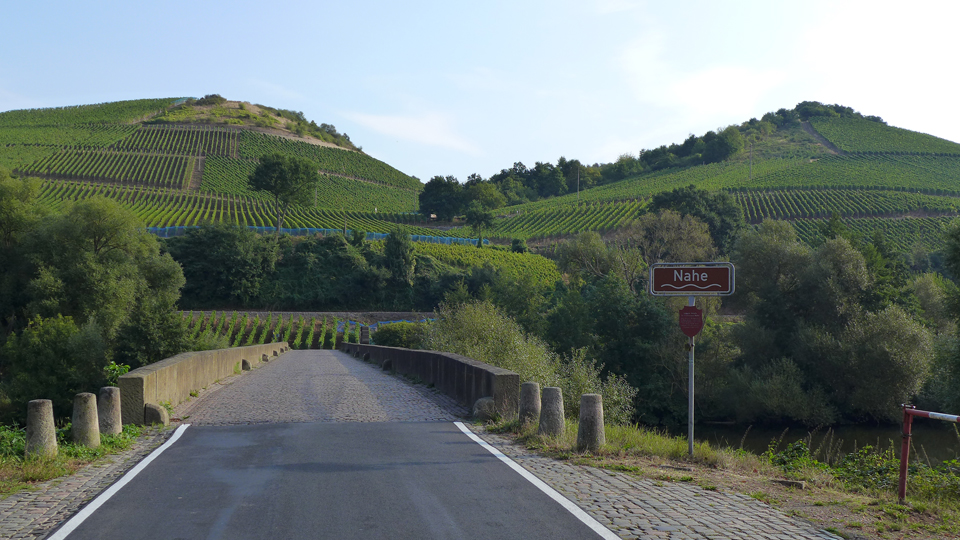
His estate’s holdings in Oberhäuser Brücke and Niederhäuser Hermannshöhle, explains Cornelius Dönnhoff, nowadays only ripen at elevated must weights, but display equal talent for both dry and residually sweet Rieslings
Apropos of by-the-glass pours, Porto Carreiro offered the intriguing opinion that, matters of price completely aside, Germany’s Riesling Grosse Gewächse are ill-adapted to that category. His argument was that proper appreciation of the often initially tight, unabashedly high-acid and phenolically incisive wines of this genre not only demanded time for the wines to open up with exposure to air, but for diners to open up to the wines as they followed their gradual evolution. Unfortunately, I suspect that the pricing of German Grosse Gewächse translates into sticker shock at all but elite North American restaurants serving sophisticated markets. Having belatedly placed considerable emphasis on village-level Ortsweine as middle-tier Riesling offerings, Germany’s VDP is hearing from many member growers that these more affordable and often youthfully more accessible alternatives to Grosse Gewächse aren’t selling well. That may often be because growers’ Gutsweine are that much more affordable and accessible, but it’s probably due in part to the fact that serious consumers of German Riesling long ago became habituated to purchasing wines labeled for their vineyards of origin, whereas the VDP’s classification and pricing “pyramid” – moderated recently in some regions, it’s true, by the introduction of a “premier cru” tier – effectively insists that if you want to drink dry Riesling worthy of single-vineyard status it won’t come cheaper than 20 Euros ex-cellar.
If I choose not to linger here in evoking the clarity and expressiveness of this seminar’s trio of Grosse Gewächse – Hermannshöhle, Goldloch and Berg Schlossberg – that’s only because I’ll shortly be publishing reviews of these and hundreds of other related 2015s, and because the discussion prompted by the seminar’s second flight of three Kabinetts was especially interesting. Each grower spoke to the special virtues of residually sweet Kabinett and to the issue of site selection for that genre. Asked why there was no Kabinett from Hermannshöhle, Cornelius Dönnhoff explained that he would have to pick much too early there to achieve a low enough must weight for Kabinett, whereas even with late harvesting, Oberhausen’s Leistenberg keeps must weights in check. I pointed out that back when I started tasting with – and buying from – Cornelius’ dad Helmut in the late 1980s, there were still years in which Hermannshöhle or Brücke didn’t make the cut for Spätlese and in which Leistenberg was chaptalized to build body despite harvest dates later than today’s, but beginning with 1988 that situation pretty much ended. (Looking back now, I see that in 1988 a portion of the fruit from Leistenberg got bottled as Spätlese, albeit from a must higher in sugar than that which informs today’s Kabinett. And the rest was chaptalized, becoming a Q.b.A.) “My father was fighting for [sugar] ripeness,” Cornelius pithily summarized, “while I’m fighting against it.” Now that there is a “premier cru” tier of Erste Lagen in the Nahe VDP’s classification scheme, Leistenberg is among those. But as I pointed out, almost by definition the VDP is never going to classify as a Grosse Lage any site that is unsuitable for rendering a Grosses Gewächs, no matter how perfect that site might be for rendering residually sweet Kabinett or Spätlese, nobly sweet Auslese, or for that matter a terrific dry wine of less than 12% alcohol. (Incidentally, the luscious, delightfully scented Dönnhoff 2015 Leistenberg is glyceral-rich in the mid-palate and incisive in finish.)
Caroline Diel’s situation seems very different on the face of it: she crafts Kabinett from the same sites as Grosses Gewächs but, as she pointed out, almost never from the same parts of those sites. So the apparent difference is really nominal, determined by the size and microclimatic diversity of one’s Einzellage. (The Diel 2015 Goldloch Kabinett combines ripe aromas with bright citricity, cut and stony underpinnings.) Leitz’s situation vis-à-vis Kabinett is extreme. “You have to ask yourself which style of wine is suited to which sites,” he explained. “I couldn’t possibly make a good Kabinett in the Rüdesheimer Berg” – well, not with today’s climate, anyway – “but it’s ideal for Grosses Gewächs, while in Klosterlay I couldn’t get the grapes ripe enough for Grosses Gewächs but they’re ideal for Kabinett.” The Leitz Magdalenenkreuz is bottled as Spätlese because he doesn’t think the site supports the quality or complexity appropriate to a Grosses Gewächs, “but if I tried to pick that site early enough for Kabinett I would have all malic acid.” And apropos of quality and complexity, I don’t fault Leitz for bottling a Klosterlay Kabinett that is outclassed by those of Dönnhoff and Diel. I suspect instead that despite its components of degraded slate and quartzite, this gentle, largely loess location simply has an inherently more limited quality potential.
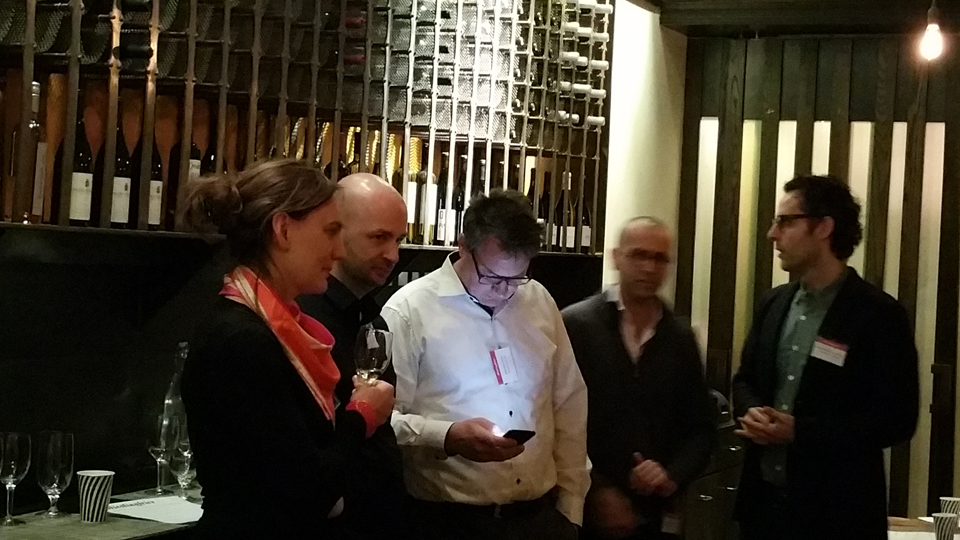
Diel, Dönnhoff, Leitz, Vaidya, Carreiro
Rieslingfeier organizer and importer Stephen Bitterolf raised a recurrent accusation that wine critics don’t give high scores to Kabinett, contributing to that category’s neglect, but instead reserve their highest scores for top Grosse Gewächse or nobly sweet wines. I consider myself as strong a supporter as there is of Kabinett, but I objected that there are really two factors involved here. I concede that many wine critics appear to score German Rieslings from a given grower in large part on the basis of must weight, alcohol and residual sugar but plead innocent personally to that charge. On the other hand, for all of the trouble involved in generating a Grosses Gewächs and given that it’s supposed to come from the best possible vineyard site, should we be surprised that at least the best such wines offer even greater complexity and depth of flavor than most Kabinetts? And as for nobly sweet Riesling, surely generations of tasters – and not merely professional critics – have not been hallucinating when they opine that an Auslese or Trockenbeerenauslese is capable of transcendent concentration, complexity and sheer palate persistence.
Asked whether their relatively low prices might be at least partly responsible for an underrating of Kabinetts, the growers pointed out that achieving Kabinett not only permits but nowadays demands that yields be higher than for other categories, a lesson that Dönnhoff’s father Helmut is fond of pointing out how reluctant and late he was to learn. And higher yields make lower prices possible. In Leitz’s case, the difference not only in crop size but also in ease of farming and harvesting between the Klosterlay and the quartet of Rüdesheimer Berg sites is obvious. (But for some contrarian suggestions, consult my account of the seminar that was entitled “Giants.”)
“Different Strokes for Different Slopes”
Flight One
2015 Eva Fricke Lorcher Krone
2015 Eva Fricke Lorchhäuser Seligmacher
Flight Two
2015 Clemens Busch Marienburg “Farhlay” GG
2009 Clemens Busch Marienburg “Farhlay” GG
Flight Three
2013 Alzinger Loibenberg Smaragd
2007 Alzinger Steinertal Smaragd
Flight Four
2013 Hitzberger Hochrain Smaragd
2007 Hirtzberger Singerriedel Smaragd
I moderated this seminar, involving Eva Fricke, Clemens Busch, Leo Alzinger and Franz Hirtzberger.
Eva Fricke poured her 2015 Lorcher Krone – reflecting a site with rich veins of quartzite that tend to promote salinity (Why? Who knows.) – alongside her 2015 Lorchhäuser Seligmacher, from a slightly deeper soil rich in active lime that is often said to be conducive to a bursting sense of brightness and back-end energy. In this instance it certainly did. Clemens Busch offered a comparison of his 2015 Marienburg Fahrlay Grosses Gewächs with the corresponding 2009. The latter was tropical-fruity and texturally rich but overshadowed by the youthful complexity, clarity and refinement of the 2015. As Busch pointed out, 160 days on the vine and seven straight weeks of clear, balmy autumn weather rendered “every grape perfect” so that he had no worries in permitting his 2015 fruit 36 hours of pre-fermentation skin contact. The wine’s bitter elements were ideally integrated and harnessed in the interest of mouth-tingling invigoration.
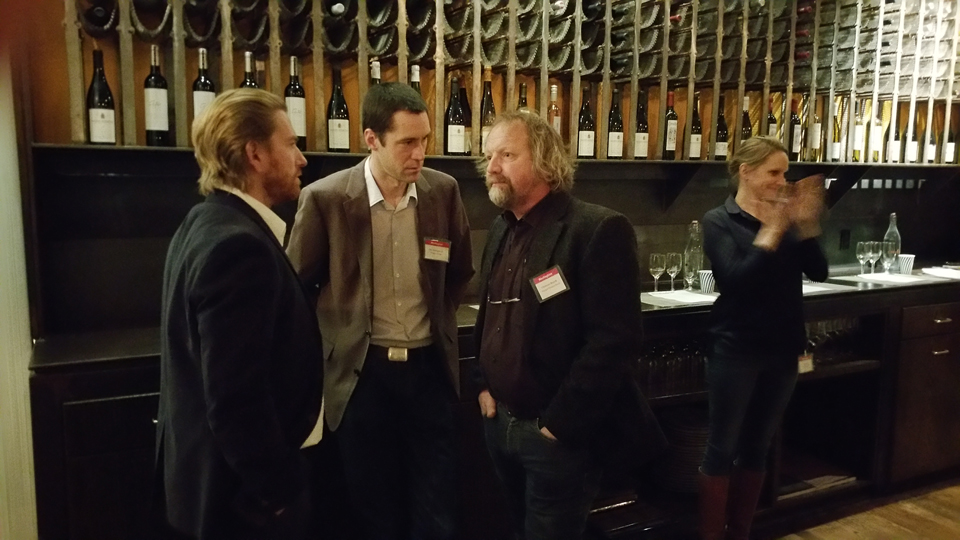
Hirtzberger, Alzinger, Busch, Fricke
Alzinger and Hirtzberger presented one Smaragd each from the great 2013 vintage and generously ripe if less distinguished 2007. But there was nothing lesser about the sensationally vibrant 2007 Steinertal that Alzinger poured alongside his 2015 Loibenberg. Why? It’s the terroir, I suggested, and Alzinger did not demur. But just what about the terroir? Perhaps it’s the combination of weathered stone and cooler influences in Schütt (which is, by the way, a German word for “rubble” or “rubbish”). Hirtzberger gets annoyed with my frequent preference for his family’s Hochrain to their Singerriedel, and in this instance the latter, while its 2007 edition was satisfyingly rich and site-typically peachy, could not for me compare to the combination of opulence and freshness – not to mention the dynamic complexity – exhibited by the 2015 Hochrain. The Hirtzbergers opine that their Singerriedel needs longer in bottle to show its true mettle than does their Hochrain, but from my experience I have to demur there too. Old vines in Hochrain and the proclivity of Singerriedel to spawn some botrytis could be decisive factors in their very different personalities and my quality assessments. Hochrain is fairly gentle and loess-dominated, which I am embarrassingly aware are the features I cited when suggesting that Rüdesheimer Klosterlay harbors less potential than the Rüdesheimer Berg sites! And I can’t say that we came to terms on this occasion with just what (allegedly) makes steep slopes special, except to agree that gentle slopes or table-like riverside sites only produce outstanding wines where their soil is exceptionally well-drained, mineral-rich and nutrient-poor. That combination arises quite frequently in the Wachau (Hirtzberger’s Kirchweg being another example) but almost never along the Mosel (Leiwener Klostergarten being a possible exception).
Might it be that certain traditionally outstanding steep slopes will, as climate changes, become disadvantaged by their proclivity to build grape sugar? Not surprisingly, the four growers who participated in this seminar largely discounted that danger and emphasized the need to modify viticultural techniques to promote flavor ripeness at the expense of sugar, although Alzinger did not disagree with my observation that in several recent vintages – notably 2012 and 2015 – large parts of the Loibenberg had a tendency to yield wines with excessive alcohol with less complete or complex flavors than those from other nearby sites. Interestingly, where excessive must weights have proven problematic in the Rheingau is not on steep slopes but rather in such—at least formerly—hallowed sites as Jesuitengarten, Marcobrunn and Wisselbrunnen, and then because proximity to the Rhine, marginally heavier soils, and less ventilation have frequently led to outbreaks of botrytis when September or early October rains coincide with still-warm temperatures. All four growers agreed that an important contribution to quality and especially to flavors that manage to outpace sugar accumulation is vine genetics, specifically the genetic mix – at once bespoke and diverse – that results from long-running massale selection.
All four of these growers were also especially well placed to address the virtues and distinctive features of terraces, not only their role in soil retention – and depth of particulate matter in the vineyards showcased in this seminar run from a maximum of two meters to a mere half meter in Alzinger’s share of Loibenberg or Busch’s Fahrlay – but also in the potential promotion of flavor diversity that is directly related to the farming challenges terraces present. Even where they are only three or four narrow vine rows deep, they can effectively represent several distinct microclimates. The row against the rocky hillside is liable to fry in sunny, hot conditions or attract botrytis in mildly warm and humid ones. Rows facing the river will enjoy superior ventilation and often also reflected light. Those in the middle might enjoy Goldilocks’ favor.
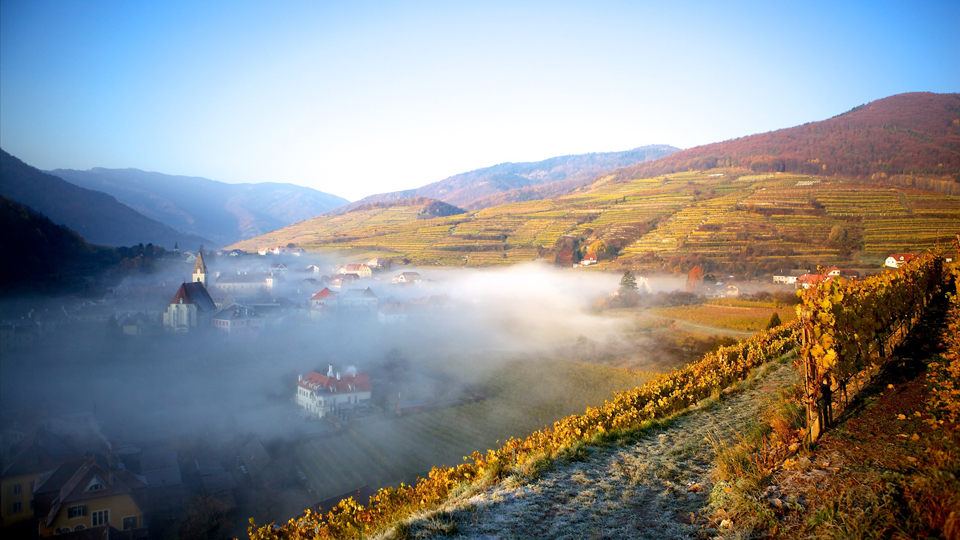
Franz Hirtzberger’s famed holdings in Spitz’s Singerriedel are among the Wachau’s many iconic instances of steep, ancient terraces
I challenged the growers on the subject of drip irrigation, which virtually all of the two Wachauers’ vines enjoy, but none of Busch’s or Fricke’s. Alzinger and Hirtzberger share with most of their illustrious neighbors the view that consistent quality such as we have come to expect since the late 1980s was unthinkable before the installation of drip lines, and I reminded seminar participants that old-timers insist the once familiar expression Sauer wie die Wachauer (sour like the Wachau) used to fit not just wines from chilly, rainy vintages but equally if not more so those from hot, dry years in which the vines simply shut down. Unsurprisingly, Busch and Fricke expressed the skepticism about irrigation shared by most quality-conscious European growers, believing that it is bound to inhibit deep root penetration and thus ultimately both metabolic balance and “mineral expression.” But our two Wachauer vintners could certainly point to both consistent vine performance and abundant vinous characteristics that provoke mineral descriptors. They insisted that the volume of water and the highly selective occasions on which it gets applied to Wachau vines precludes their becoming lazy or shallow-rooted.
“Giants: 2005 vs. 2015”
Flight One
2005 Vollenweider Riesling Goldgrube Kabinett
2015 Vollenweider Riesling Goldgrube Kabinett
Flight Two
2005 Selbach-Oster Riesling Zeltinger Sonnenuhr Spätlese *
2015 Selbach-Oster Riesling Zeltinger Sonnenuhr Spätlese *
Flight Three
2005 Schloss Lieser Riesling Juffer Sonnenuhr Auslese GK
2015 Schloss Lieser Riesling Juffer Sonnenuhr Auslese GK
Flight Four
2005 Egon Müller Riesling Scharzhofberg Auslese GK
2015 Egon Müller Riesling Scharzhofberg Auslese GK
This perhaps slightly hyperbolically titled seminar was organized and moderated by Stephen Bitterolf to explore what makes a great vintage. It featured Thomas Haag of Schloss Lieser, Egon Müller, Johannes Selbach of Selbach-Oster and Daniel Vollenweider. Bitterolf posited that a great vintage is one in which the consumer will have difficulty making a bad choice, a view that went uncontested on this occasion.

Selbach, Vollenweider, Haag, Müller, Bitterolf
Suggestively, Daniel Vollenweider had been asked to lead off with a pair of Wolfer Goldgrube Kabinetts. Can this lightest and (at least traditionally) most easily achieved Prädikat really exemplify a great vintage? “Two thousand five was more of a Spätlese vintage,” Vollenweider admitted, “so perhaps my Kabinett from this year is a little too concentrated.” But his 2015 – strong on carnal, mineral and floral attributes – deliciously displayed both levity and cut. Asked by Bitterolf to also address Kabinett, both Haag and Selbach emphasized the increasing importance of site selection in achieving grapes that ripely reflect their sites and vintages while remaining low in potential alcohol, and I pointed out that Ernie Loosen has suggested that “nowadays my Kabinetts are the real Auslesen,” meaning that selective picking is sometimes required in order to avoid including clusters that are too high in sugar or advanced in flavor to promote Kabinett virtues, whereas in some years the statistically average cluster weight is well above the legal threshold for Auslese. Selbach emphasized his desire to defend “true Kabinett” as a category that’s not only light and infectiously drinkable but also “crunchy and restrained in sweetness.” Egon Müller expressed his by now familiar objections to Kabinett as a light wine category. At his estate, he treats that Prädikat as synonymous with Naturwein as it was used before 1971 – i.e., as the name for an unchaptalized wine fully able to serve as a calling card for its site and producer.
Johannes Selbach presented a pair of "one-star" (i.e., superior though not necessary riper) Spätlesen from the Zeltinger Sonnenuhr. The 2005 displayed site-typically heady floral perfume and a superb combination of creamy richness with still-crisp edges, while the 2015 exhibited mouthwateringly saline, meaty savor that I fully expect will follow it into a delayed maturity. In contrast with Selbach’s image of Spätlese as full ripeness, and Haag’s intention that it be botrytis-free, Egon Müller averred that “for me Spätlese is from slightly overripe grapes, which could include botrytis.”
The lavish second half of this seminar featured a pair each of gold capsule Auslesen from Haag’s Brauneberger Juffer-Sonnenuhr and Müller’s Scharzhofberg. For all of its vintage-typical lusciousness and subtle creaminess, Haag’s 2005 displayed delightful levity as well as an underlying stoniness that is nicely encompassed by his description of Mosel Riesling as ideally retaining a “cool background.” The weather was cooler in 2005 than in 2015 with its freakish summer heat. Yet the tart combination of bright acidity and chewy phenolics that greeted tasters of Haag’s 2015 is not unusual among top Mosel Rieslings of that vintage. Egon Müller elaborated on this phenomenon. “I misread 2015 at first,” he explained, “because of a canicule [heat wave] that you could only compare with 2003. But the autumn of 2005 was warmer, despite less summer heat.” That warmer autumn was decisive in determining the typical vintage character of Mosel 2005s. That said, I wouldn’t call Egon Müller’s 2005 gold capsule Auslese vintage-typical. Its generous, nectarous quince and apricot flavors were shot through with saliva-drawing salinity and eye-wateringly bright acidity, leading to a finish of sensational sheer grip. The reverberating 2015 Scharzhofberger gold capsule Auslese evoked Rainier cherry and quince preserves laced with herbal liqueur and fresh Meyer lemon. I called attention to a faintly blue cheese-like hint of overtly fungal botrytis character. “If we did a proper job of selecting,” said Müller, “then that will disappear as the wine matures.”
The growers’ general observations on Auslese proved fascinating. “For me,” declared Vollenweider, “Auslese is always 100% botrytis, and ‘selection’ implies botrytis.” But while he conceives of noble rot as an adjunct to full ripeness, Egon Müller expressed a preference for botrytis attacking grapes that are “not quite fully ripe, and then contributing to their ripening and concentration.” Johannes Selbach expressed a strongly contrasting view—or at least preference. “I firmly believe in the old-style ‘drinking Auslese’,” he said, “with at least a portion coming from ripe, fresh, healthy grapes.” In seeming defiance of this Prädikat’s literal meaning, he advocated a return to an allegedly traditional notion of Auslese as something “not selected but grown, and which you couldn’t make every year.” The block pickings from top locations that nowadays serve for Selbach-Oster flagship bottlings (and which I discussed at length in my report on this estate’s 2014s) exemplify this ideal of capturing site and vintage by means of a single picking incorporating whatever is hanging in the vineyard, subject to prior culling of any manifestly impaired fruit). The grapes gathered in this single pass will reflect a ratio of healthy to botrytized fruit as well as heterogeneity in acidity, phenolic evolution and berry size that are specific to its time and place. But Selbach readily notes that he still renders selectively picked Auslesen in years he deems appropriate.
“Radikals”
Flight One — Saar
2014 Hofgut Falkenstein Riesling Sekt Brut
2014 Hofgut Falkenstein Riesling Herrenberg Kabinett Dry
Flight Two — Swabia
2014 Beurer Riesling “Junges Schwaben” Dry
2011 Beurer Riesling “Ohne Alles”
Flight Three — Rheingau
2015 J.B. Becker Rieslingf Walkenberg Spätlese “Alte Reben”
2009 J.B. Becker Riesling Walkenberg Spätlese “Alte Reben”
Flight Four — Pfalz
2015 Von Winning Riesling Reiterpfad Erste Lage
2014 Von Winning Riesling Ungeheuer GG
Paul Grieco, veteran sommelier and owner of Terroir in New York City’s Tribeca, commenced moderating this seminar featuring Hans-Josef Becker, Jochen Beurer from Württemberg, Andreas Hütwohl from Von Winning and Johannes Weber of Hofgut Falkenstein by reminding us that, when applied to people, “radical” can mean various things, of which he chose to emphasize the sense of authenticity and steadfastness in one’s convictions. Personally, though, I don’t believe that the four folks who presented their wines on this occasion have any reason to shy away from being called radicals in the sense of extremists. And given the quality and intrigue on exhibit in the glass, they can take pride in that extremism.
When in 1981 Erich Weber established his Hofgut Falkenstein (about which one can read much more in my report on that estate’s 2014s), he dedicated himself to viticultural and cellar regimens that he was confident would have been taken for granted a half century or more earlier but knew full well were in complete opposition to then prevailing techniques and styles. As son Johannes brashly put it on this occasion, his principle was “don’t give a shit about what others say [but] find customers for your style.” Weber Senior was so successful in the latter endeavor that for a quarter century—my own very small-scale importation of his wines from the late 1980s representing a minor exception—his wines sold out almost as quickly as they were bottled to a shockingly small number of mostly north German wine drinkers (he still loves to emphasize the word “drinkers”) to whom he personally delivered load after large load in his van. Only since vintage 2012 have his wines had a retail or restaurant presence anywhere on earth, and then largely in the U.S. thanks to Trier-based American Mosel wine expert Lars Carlberg (who now also works the vines and cellar alongside the Webers).

Erstwhile radical: Three decades after he founded Hofgut Falkenstein, Erich Weber’s turn-back-the-clock approach, with son Johannes as ambassador, is garnering international attention
Johannes Weber presented his 2014 Riesling Sekt and Niedermenniger Herrenberg Kabinett Trocken, the latter an adamantly dry, rivetingly intense Riesling of just 11% alcohol that combines complexity and levity in a manner scarcely achievable outside the world of German Riesling, and unfortunately nowadays attempted by very few growers. Speaking of radical, I reminded the young Weber that when he made his Rieslingfeier debut in 2016, I urged him to present this Kabinett trocken but he and Carlberg thought it might be too extreme to meet with widespread acceptance even among avowed Riesling fanatics.
Jochen Beurer helpfully clarified that although he bottles a dry Riesling called Junges Schwaben because that’s the name of his small circle of young, quality-conscious Württemberg vintners (the rest of whom don’t grow Riesling), the notion that he or his wines are “Swabian” is a fancy perpetrated by his U.S. importer that has caught on, even though most of what Germans nowadays referred to as Schwaben is not winegrowing territory. Much of it is in Bavaria rather than Württemberg, and stretching “Swabia” to cover Beurer’s compatriots in Baden, as I’m now seeing done stateside, is a notion that hadn’t occurred to anyone since the 18th century. Beurer’s Rieslings favor mid-palate grip; flavors best captured via mineral vocabulary; and a style I’d call “rustic” provided it’s understood that rusticity can be relished. Alongside his 2014, Beurer presented a 2011 for which the word “radical” perfectly fits. Its name, Ohne Alles [“sans everything” is how Shakespeare put it], and the fact that its 2012 successor is still in barrel tell you most of what you need to know. It’s fair to say that this unabashedly oxidative wine divided opinions but every taster found it intriguing.
That sticking to one’s guns can keep you looking radical indefinitely is proven by Hans-Josef Becker (about whom I’ll write at length in an upcoming report focused on vintage 2015 along the Rhine). Becker, who presented along with his young Geisenheim-trained wife and eventual successor Eva, came of wine-growing age in the 1960s, when parallel to managing their family’s estate he and his sister acted as Frank Schoonmaker’s (later Chateau & Estate Wines’) local commissioner and logistics director. As such, Becker was, well into the 1980s, a conduit for much of what American consumers experienced by way of great German Riesling, but he remained unknown to them because he was content for merely minuscule volumes of his own wine to cross the Atlantic. As he related on this occasion, he was lucky to have had his earliest cellar experiences at the once justly renowned Schloss Eltz in 1963, where he delighted in tasting the young wines from cask but was then shocked and crestfallen at being told that these were simply raw materials and would get sweetened up before bottling.
The following year, Becker took the reins at his family’s estate determined to emphasize dry Riesling from low-yielding vines. And as trends set in of stainless steel upbringing and bottling three to nine months after harvest, Becker resisted them, persisting instead in giving his wines at least a year in cask. Along with the high-toned esters (at times faintly mothball-like), spices and subtly oxidative complexity that reflect their élevage, Becker’s Rieslings display astoundingly diverse mineral nuances and in many instances an uncanny combination of levity and cut with pungent concentration and mid-palate richness. As he explained, resisting the viticultural trends of his youth also meant preserving old vines, training them relatively low to the ground and encouraging a full canopy, all measures conducive to keeping must weights in check despite low yields and late harvest. The wines presented on this occasion – Wallufer Walkenberg Spätlese Alte Reben from vintages 2015 and 2009 – reveal already in their names that Becker also resists recent marketing and labeling trends associated with Germany’s VDP (of which, needless to say, he isn’t a member). “Spätlese” here signifies not only literal late harvest but the epitome of full, balanced ripeness, and he doesn’t consider it necessary to advertise that these wines are legally trocken given that we’re talking about his estate’s flagships. (Becker does bottle residually sweet and off-dry wines, including Auslesen that count as highly unconventional by contemporary standards—or for that matter by those that prevailed in the Rheingau of his youth. He also crafts some of Germany’s most fascinating Pinots, a tale for another time.)
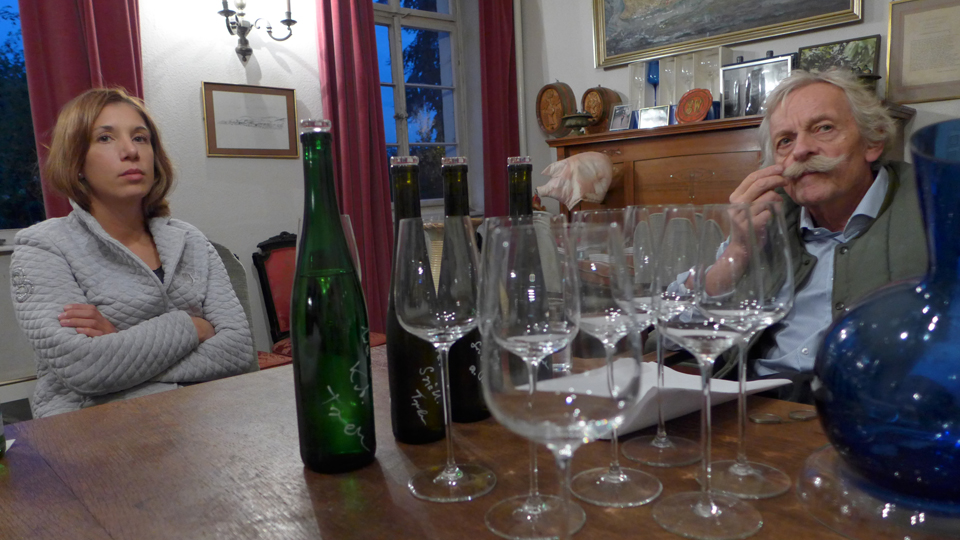
Once and Future Radical: Hans-Josef Becker rejected prevailing German practices in the 1960s, and his Rheingau Rieslings are still out-of-step with fashion, as he and his wife Maria deliciously demonstrated at the 2017 Rieslingfeier
Andreas Hütwohl takes the marketing and business lead in the talented young trio guiding Weingut von Winning, the Deidesheim-based estate that for most of its history was known as Dr. Deinhard. Like vineyard manager Joachim Jayer and winemaker Stephan Attmann, not to mention dozens more of the most talented Pfalz Winzer of his and an earlier generation, Hütwohl’s vision of wine and viticulture is inspired by legendary cellarmaster Hans-Günter Schwarz, who also happens to be his stepfather. On this occasion, Hütwohl presented a 2015 Ruppertsberger Reiterpfad and a 2014 Forster Ungeheuer Grosses Gewächs that revealed what leads some wine critics and fellow vintners to consider von Winning’s Rieslings inappropriately radical—namely, their being raised in casks frequently of only 500-liter capacity and sometimes new or nearly new. From the first (2008) vintage under the new team (assembled by the late Achim Niederberger, who also acquired the Bassermann-Jordan and von Buhl estates), it was my impression that what overtly woody, resinous elements were to be found in the von Winning wines did not preclude clarity and definition, vineyard character or nuance.
But it would have been wonderful if the seminar attendees could have tasted the 2008 Forster Jesuitengarten Grosses Gewächs that Hütwohl brought to the following night’s Gala Dinner. (A double magnum, it would have been more wine than required to serve the 50 people gathered for this seminar.) This wine represented the contents of just a single new 500-liter cask (and the first tiny-berried crop from replanted vines) and its combination of high-toned aromatic intensity, soothing textural richness and transparency to myriad floral, herbal and mineral nuances were no less alluring than when the wine was young. But to the present point, you now had to look carefully to detect even hints of wood resin, and as always with von Winning Rieslings the wood hasn’t in the least robbed its finish of refreshing primary juiciness. The convention adopted at this estate is that all von Winning wines are dry (off-dry or unabashedly sweet bottlings turn up among those still marketed under the Dr. Deinhard label) but another treat sprung on a lucky few attendees at the Rieslingfeier was a coolingly minty, soothingly lingering 2013 Forster Pechstein Riesling Auslese, one of 300 375-ml. exceptions to the dry rule, and a wine I hadn’t even known existed.
If there is one essential takeaway from the 2017 Rieslingfeier seminars it is surely this: Given the extreme sensitivity of Riesling to site and growing season, combined with its unique stylistic malleability, there is bound to be an especially large range of issues to discuss among growers, trade and consumers as well as lots of room for healthy argument and disagreement. The best way to avoid these discussions becoming unnecessarily ideological is for them to take place over shared glasses of Riesling, where the focus can remain on taste. Those whose self-appointed task is widening the consumer base for fine Riesling understandably lament the prevalence and stubborn persistence of inappropriate misconceptions about this grape and its wines. But there are plenty of misconceptions and preconceptions worth addressing within the community of already committed Riesling-loving wine growers, tradespeople and consumers as well. And the most persuasive case or definitive counterargument for any principle you choose to posit about Riesling is probably in a glass right under your nose.
You Might Also Enjoy
Rieslingfeier: A Celebration of Germany’s Greatest Wines, David Schildknecht, July 2017
Mosel 2015: Rain in the Nick of Time, David Schildknecht, June 2017
Saar and Ruwer 2015: Rain in the Nick of Time, David Schildknecht, May 2017
Austria’s 2015 Rieslings and Grüner Veltliners: Ripe and Ready, David Schildknecht, February 2017
2014 on the Mosel: Man Bats Last, David Schildknecht, November 2016
2014 Mosel: A Hard But Often Rewarding Harvest, David Schildknecht, October 2016
Rescuing Ruwer Riesling in 2014 ... and Beyond, David Schildknecht September 2016
